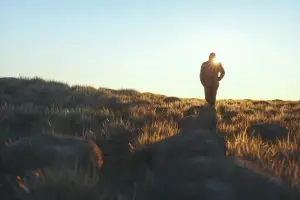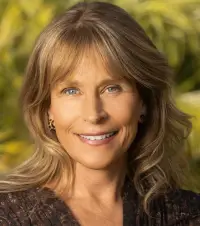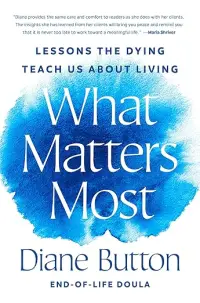Imagine you knew you were dying soon. What would matter most to you? How would you change the way you spend your time? How would you reflect on your life? Whom would you want near?

These are common questions for the dying, according to end-of-life doula Diane Button. She and her colleagues at the End of Life Doula Alliance sit with people who are dying and their loved ones to help them through the practical, emotional, and spiritual aspects of dying. By listening to people’s stories and shepherding them through the process, she’s witnessed firsthand what people care about most and what brings them peace at the end of life.
In her new book, What Matters Most: Lessons That the Dying Teach Us About Living, Button shares poignant stories of individuals who have faced impending death and what she’s learned from their experiences. Her book not only serves as a primer for dying well, but also as a source of important lessons for anyone wanting to live life with more intentionality.
I spoke with her about her book and what we should take away from it.
Jill Suttie: How does facing imminent death change the way people think about their lives?
 Diane Button© Photo by Jane Richey
Diane Button© Photo by Jane Richey
Diane Button: When people are facing the end of life, everything that is superficial just gets stripped away. The idea of taxes and politics and other things that we worry about are just gone, and you’re really focusing on love, relationship, healing, and, oftentimes, spirituality, because that’s something a lot of people believe they’re going to take with them when they die. The world becomes smaller in certain ways, but also just so profound and raw and beautiful. There’s often so much joy at the end of life. It’s amazing.
JS: Why is there joy?
DB: It’s surprising, but people at the end of life are some of the most joyful people I’ve ever known. At first I asked myself, why is there so much joy in the room when working with the dying? But then I figured it out, and it’s really simple. I think that they’re consciously looking for joy. They’re not stuck in the past and they’re not fixated on the future. They’re here, they’re present.
There’s a freedom that comes when time is short and all your expectations fade, your to-do list goes away, and you’re focused on what’s right in front of you. It might be holding someone’s hand or the simple things of an ordinary day, like the sun shining on your face. Pausing to acknowledge the joy that’s right in front of us is a huge benefit to everyday life.
JS: What are some of the common themes that come up when people are dying?
DB: People want to know that they’re going to be remembered. They want to know that their life mattered and that they made a difference. And so we’re often talking about what people have contributed to the world during their lives.
People also want to be sure that everyone they love knows that they’re loved. Oftentimes they’re making calls in the last week of life, calling their friends from the past, sometimes people they haven’t talked to in decades. Expressing love and saying goodbye and thank you is such an important part of end of life.
Another thing is unfinished business. People really want to take a look at any parts of their life where they might need to ask for forgiveness. Sometimes people have been holding on to something for decades, and it becomes urgent at the end of life to let it go.
JS: I found many of the stories in your book to be very moving. But one in particular stood out for me—the mother who’d abandoned her children and wanted to ask for forgiveness. How does listening to stories like hers affect you?
DB: Witnessing people’s stories has really changed my life. Sometimes they’re beautiful stories and I think, Oh, I want to have an ending like that. But sometimes they’re really hard stories, and it’s a lesson in a different way for me.
This woman named Carrie had left her family—her teenage daughters, her work, everything—and moved to California to be with a man that she fell in love with. When she was diagnosed with cancer, which later became terminal, the fact that she had abandoned her family was, at first, not really percolating. She was worrying about her medicine, her treatments, and such.
But once I got to know her and she told me the honest story, I realized that there was real big unfinished business that she was holding on to. So, we talked about it. These are the hard conversations, but they’re also the most profound. It took me a few visits of just sitting and processing it before I really understood the depth of what she was going through. I didn’t recommend anything. I just listened and I asked a few questions that gave her the opportunity to pause and reflect on what would matter most to her in her last few days and weeks of life. In the end, she actually got on a plane and went back to be with her family.
JS: Are there any lessons from the dying that you particularly took to heart—maybe something you hadn’t considered before?
DB: One of the most important lessons I learned came from a few different stories in the book—the idea of living in the moment in a different way, pausing to really take in something beautiful.
That’s the biggest change I’ve made in how I live my life. Hour by hour, and sometimes moment by moment, I’ll really pause if I see a beautiful flower, rock, or heart-shaped leaf, or when looking into my friend’s eyes or even at a loaf of bread, sometimes. I’m realizing that there’s beauty everywhere and that I was just spinning through life so fast that I wasn’t pausing to take it in.
So, I’ve actually created a practice for myself where at least once a day I pause for a minute and stare at something beautiful, whatever I see. Really being there in that minute takes me away from the stress and the fast pace. And when I say thank you to somebody, I try to be specific now with my gratitude. I say “Thank you for bagging my groceries, thank you for spending this time with me.” It’s helped me to pause, to be in the moment, and really think about it rather than just saying thank you and passing through.
JS: That’s beautiful.
DB: Do you want me to share a story from the book?
JS: Yes, please.
 What Matters Most: Lessons That the Dying Teach Us About Living (The Open Field, 2025, 252 pages).
What Matters Most: Lessons That the Dying Teach Us About Living (The Open Field, 2025, 252 pages).
DB: One of my favorite stories in the book was told to me by my doula friend, Gabby Jimenez, who had a client named Jacob with a glioblastoma (a fast-moving brain tumor). He’d been a very active man, always outdoors and just a nature lover, and now he was confined to his bed. When Gabby went to visit him, he had a grab bar above his bed with a bunch of colorful bracelets hanging down and a tally counter in the middle—like the kind you would see at a baseball game.
Gabby asked him about it, and he said, “That’s my joy counter.” Over time, he’d realized that although his life had changed dramatically, and he had gone through depression and sadness, he was still experiencing joy. So, he had this joy counter, and he would click it every time that he had an experience of joy—like a friend coming to visit, click, a bite of his favorite ice cream, click, a hug from his wife, click, click.
That became his way of remembering the joy in his everyday life. And I thought that was really, really beautiful. It’s surprising, when you’re paying attention, how many beautiful moments there are in an ordinary day. That was a great lesson.
JS: Many people want to focus on leaving a legacy behind. How does that help someone when they’re dying?
DB: Leaving a legacy will be both tangible and intangible and offers benefits both to the dying person and those they are leaving behind. Our legacy is a way for us to feel that our lives were valued, that we will be remembered, and that we made a difference.
This can be accomplished through a legacy project by creating something tangible such as a letter, recording, or photo album to leave behind. Or it can be the intangible legacy work, which involves the client thinking through how people are going to remember them and what the most fulfilling parts of their life were. It helps them feel good about the entirety of their life and how they’ve lived. And it also helps reveal any unfinished business that might need to be addressed.
Heartfelt, personalized legacy projects can become beautiful memories for the people they leave behind—partners, children, friends, people they’ve spent their lives with. It’s a way of ensuring their memory and their stories will live on and that they were a significant and meaningful link in the generational chain.
JS: So many lessons you write about seem important. But the one I practice most, perhaps, is expressing love directly to people I love. Yet it seems many people are reluctant to do that.
DB: I think there are certain people who just don’t say the words. They spend their life showing their love and not verbalizing it. But at the end of life, it becomes urgent. Those unspoken words can really build up.
Oftentimes we’re spending sessions with clients making calls, writing letters, texting, finding people on Facebook. That’s part of the inventory that people do at the end of life. They’re processing what their life has been all about and remembering people, and those people often pop up and want to reach out.
That’s why I think it’s really helpful to do this work all along the way, to say the words “I’m sorry” or “I love you” and make the phone calls and ask for forgiveness, or give forgiveness when it’s appropriate. When you do those things during the course of your life, then you avoid the buildup of unfinished business at the end.
JS: Many of the practices for living well have solid science behind them—like forgiveness, gratitude, kindness, meaning, self-compassion. Do you think hearing about them from people who are dying gives them more poignancy somehow?
DB: I think looking at forgiveness, gratitude, meaning, love, joy through the lens of the dying gives them a new perspective, because none of us has died before. To be able to hear the stories of what’s likely going to be most important to you at the end of life gives you the opportunity to live life through that lens right now.
The biggest takeaway from the book is to not be afraid to lean into conversations around end of life and to think about your own end of life. Because, really, talking about death is talking about life. If you start to understand what, for you, is most important and what might be most meaningful for you at the end of life, then you can live differently now. I feel like that’s a gift.

